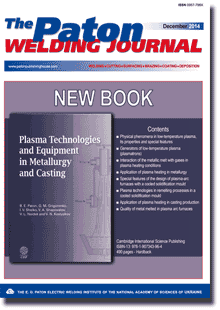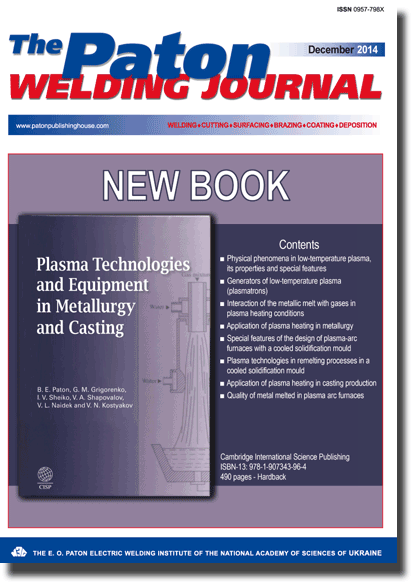| 2014 №12 (01) |
DOI of Article 10.15407/tpwj2014.12.02 |
2014 №12 (03) |

The Paton Welding Journal, 2014, #12, 8-10 pages
Tribotechnical properties of deposited metal of 50Kh9S3G type with increased sulphur content
V.V. Osin
E.O. Paton Electric Welding Institute, NASU. 11 Bozhenko Str., 03680, Kiev, Ukraine. E-mail: office@paton.kiev.ua
Abstract
Steels alloyed with sulphur (for instance, silchrome) are widely applied in manufacture of tools for cold rolling of metal. Their reconditioning repair requires materials ensuring deposited metal composition close to that of baze metal. The work is a study of sulphur influence on tribotechnical properties of deposited metal of 50Kh9S3G type. Sulphur content in the deposited metal was varied in the range of 0.02 to 1.70%. Investigations revealed that sulphur forms complex sulphides, which prevent seizure of interacting metal surfaces, thus increasing deposited sample wear resistance. To ensure optimum tribotechnical properties of deposited metal, volume content of complex sulphides of the main alloying elements should be within 1.5 to 2.0 %, and their dimensions should be ≤0.02 mm. This condition is ensured at total content of sulphur of 0.5-0.8 % in the deposited metal. At lower sulphur content the quantity of forming sulphides is insufficient to make an essential influence on deposited metal properties. At higher sulphur content the forming coarse sulphide inclusions are less strongly retained by deposited metal matrix and during testing they crumble and are removed from the wearing zone. This adversely affects wear resistance of deposited metal and contacting part. 10 Ref., 2 Tables, 3 Figures.
Keywords: deposition, deposited metal, sulphur alloying, sulphides, tribotechnical properties
Received: 20.10.14
Published: 29.12.14
References
1. Ryabtsev, I.A., Kondratiev, I.A. (1999) Mechanised electric arc surfacing of metallurgical equipment parts. Kiev: Ekotekhnologiya.
2. Fedorchenko, I.M., Pugina, L.I., Slys, I.G. et al. (1973) Bearing sulphurised metal-ceramic materials on the base of stainless steels. In: Friction and wear at high temperatures, 115-120. Moscow: Nauka.
3. Vinogradov, Yu.M. (1965) Sulphidizing, selenizing and tellurizing of steels, cast iron and alloys. Metallovedenie i Termich. Obrab. Metallov, 10, 36-41.
4. Kovalchenko, M.S., Sychev, V.V., Tkachenko, Yu.G. et al. (1973) Influence of temperature on friction characteristics of some sulphides, selenides and tellurides of refractory metals. In: Friction and wear at high temperatures, 133-138. Moscow: Nauka.
5. Artamonov, A.Ya., Barsegyan, Sh.E., Repkin, Yu.D. (1968) Examination of lubricating properties of molybdenum and tungsten disulphides. Poroshk. Metallurgiya, 12, 53-58.
6. Samsonov, G.V., Barsegyan, Sh.E., Tkachenko, Yu.G. (1973) On mechanism of lubricating action of sulphides and selenides of refractory metals. Fiz.-Khimich. Mekhanika Materialov, 9(1), 58-61.
7. Lunev, V.V., Averin, V.V. (1988) Sulphur and phosphorus in steel. Moscow: Metallurgiya.
8. Osin, V.V., Ryabtsev, I.A. (2004) Effect of sulphur on properties of iron-base alloys and prospects of its application in surfacing materials. The Paton Welding J., 10, 18-21.
9. Osin, V.V., Ryabtsev, I.A., Kondratiev, I.A. (2006) Study of sulfur effect on properties of deposited metal of Kh5MFS type. Ibid., 12, 12-15.
10. Ryabtsev, I.I., Chernyak, Ya.P., Osin, V.V. (2004) Block-module unit for testing of deposited metal. Svarshchik, 1, 18-20.
Suggested Citation
V.V. Osin (2014) Tribotechnical properties of deposited metal of 50Kh9S3G type with increased sulphur content. The Paton Welding J., 12, 8-10.The cost of subscription/purchase order journals or individual articles
| Journal/Currency | Annual Set | 1 issue printed |
1 issue |
one article |
| TPWJ/USD | 384 $ | 32 $ | 26 $ | 13 $ |
| TPWJ/EUR | 348 € | 29 € | 24 € | 12 € |
| TPWJ/UAH | 7200 UAH | 600 UAH | 600 UAH | 280 UAH |
| AS/UAH | 1800 UAH | 300 UAH | 300 UAH | 150 UAH |
| AS/USD | 192 $ | 32 $ | 26 $ | 13 $ |
| AS/EUR | 180 € | 30 € | 25 € | 12 € |
| SEM/UAH | 1200 UAH | 300 UAH | 300 UAH | 150 UAH |
| SEM/USD | 128 $ | 32 $ | 26 $ | 13 $ |
| SEM/EUR | 120 € | 30 € | 25 € | 12 € |
| TDNK/UAH | 1200 UAH | 300 UAH | 300 UAH | 150 UAH |
| TDNK/USD | 128 $ | 32 $ | 26 $ | 13 $ |
| TDNK/EUR | 120 € | 30 € | 25 € | 15 € |
AS = «Automatic Welding» - 6 issues per year;
TPWJ = «PATON WELDING JOURNAL» - 12 issues per year;
SEM = «Electrometallurgy Today» - 4 issues per year;
TDNK = «Technical Diagnostics and Non-Destructive Testing» - 4 issues per year.


